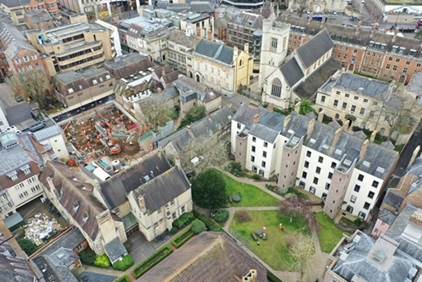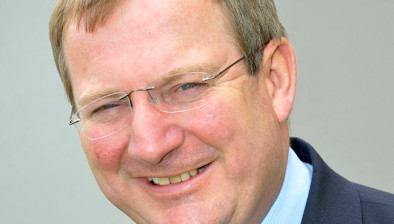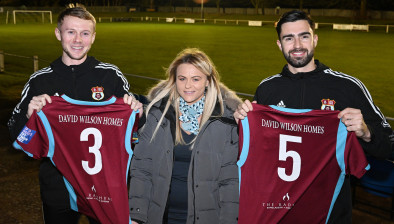And finally… Ancient burial mound unearthed at Oxford University’s ‘lost college’
The archaeologists who uncovered Oxford University’s ‘lost college’ think they have now discovered evidence of a 4,000-year-old prehistoric burial mound beneath it.

Aerial view of the excavations (Photo credit: Oxford Archaeology)
A fragment of skull and part of a human jawbone with some teeth still in place has been unearthed, together with remains typical of a Bronze Age barrow used for human burials.
The findings by Oxford Archaeology follow their recent discovery of part of the limestone foundations of the former St Mary’s College, which was founded for Augustinian Canons studying in Oxford but was abandoned following the Dissolution of the Monasteries by Tudor monarch Henry VIII towards the end of his reign.
The archaeological dig has been taking place on a site where construction firm Beard is developing 30 student rooms at the Frewin Annexe of Brasenose College, where Grade II* listed Frewin Hall is located within Oxford’s old city walls.
Oxford Archaeology’s senior project manager Ben Ford said it appeared the south-eastern part of St Mary’s College – known as the ‘lost Augustinian college’ because so little of it remains today – had been built on top of part of what was once a circular burial mound.
He said: “Locating part of the original massive limestone wall foundation of St Mary’s College was a significant archaeological discovery, and it is exciting to have now discovered underneath it and nearby the remains of an earthwork, a fragment of skull, and part of a human jawbone.
“These intriguing discoveries strongly suggest a prehistoric burial mound was on this site thousands of years before Oxford even existed. The jawbone is robust and clearly from an individual of some stature. The mound is built from reddish colour soils and natural gravel – its survival is very unusual.
“We are now searching for the circular ditch which would have surrounded it, and the remaining bones of the individual.”
Ben Ford added that Oxford is situated on a long north-south promontory between the River Thames and the River Cherwell, and there have been previous discoveries of Bronze Age barrows, and an earlier Neolithic henge.
He explained: “In the Neolithic era the Oxford promontory was probably a sacred area, which remained significant in the Bronze Age when it became an extensive burial ground to commemorate powerful and important people from local communities, under large earthen mounds.
“Frewin Hall is one of the oldest buildings still in use in the city, and when we started this project, we hoped to uncover evidence of Oxford’s earliest years as a fortified Saxon town, as well as its later use as the residence of some of Oxfords most powerful Norman families.
“However, it had not been previously documented that there was a prehistoric burial site here. This rare discovery brings a new dimension to what is known about this rich archaeological area, and we are grateful to Brasenose College for making this possible by funding the excavation.”
A selection of artefacts discovered by the team from Oxford Archaeology were put on display at a recent open day. They included near complete ceramic wine or beer jugs, bone objects, coins, glass vessels and highly decorated window glass, along with decorated floor tiles and glazed roof tiles from the medieval period.
Members of the public were also given guided tours by experts from Oxford Archaeology, and were able to see the excavations, from viewing areas especially built for the event by construction firm Beard.
Peter Beilby, project manager at Beard said “We stopped work for the day and opened the gates. Despite the weather we received 500 visitors to view the excavations. It was fantastic, a huge success.
“We collaborated closely with the team from Oxford Archaeology during the excavations, and also on the run-up to the event.
“It was decided to construct the viewing areas for the public open day so that people could see the excavated areas safely while getting a full picture of the archaeological work that has taken place.”
Ben Ford added: “There is so much interest in the archaeology of this great city – it’s always a special day when we can show off our discoveries in this way.”





















